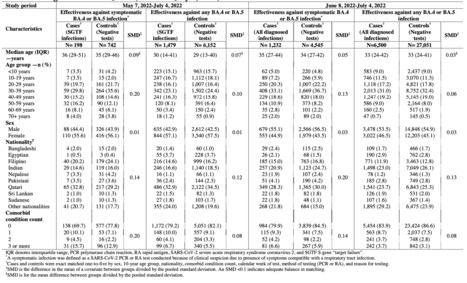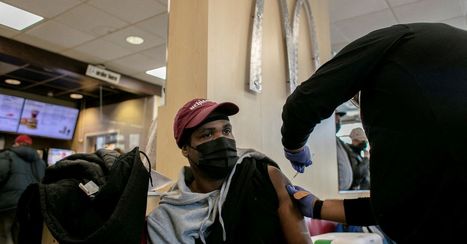 Your new post is loading...

|
Scooped by
Juan Lama
|
This study estimates the effectiveness of previous infection with SARSCoV2 in preventing reinfection with Omicron BA.4/BA.5 subvariants using a test negative, case control study design. Cases (SARSCoV2 positive test results) and controls (SARSCoV2 negative test results) were matched according to sex, 10 year age group, nationality, comorbid condition count, calendar week of testing, method of testing, and reason for testing. Effectiveness was estimated using the S gene target failure (SGTF) infections between May 7, 2022 and July 4, 2022. SGTF status provides a proxy for BA.4/BA.5 infections, considering the negligible incidence of other SGTF variants during the study. Effectiveness was also estimated using all diagnosed infections between June 8, 2022 and July 4, 2022, when BA.4/BA.5 dominated incidence. Effectiveness of a previous pre-Omicron infection against symptomatic BA.4/BA.5 reinfection was 15.1% (95% CI: -47.1 to 50.9%), and against any BA.4/BA.5 reinfection irrespective of symptoms was 28.3% (95% CI: 11.4 to 41.9%). Effectiveness of a previous Omicron infection against symptomatic BA.4/BA.5 reinfection was 76.1% (95% CI: 54.9 to 87.3%), and against any BA.4/BA.5 reinfection was 79.7% (95% CI: 74.3 to 83.9%). Results using all diagnosed infections when BA.4/BA.5 dominated incidence confirmed the same findings. Sensitivity analyses adjusting for vaccination status confirmed study results. Protection of a previous infection against BA.4/BA.5 reinfection was modest when the previous infection involved a preOmicron variant, but strong when the previous infection involved the Omicron BA.1 or BA.2 subvariants. Protection of a previous infection against BA.4/BA.5 was lower than that against BA.1/BA.2, consistent with BA.4/BA.5 greater capacity for immune system evasion than that of BA.1/BA.2. Preprint available at medRxiv (July 12, 2022): https://doi.org/10.1101/2022.07.11.22277448

|
Scooped by
Juan Lama
|
The lineages’ rise seems to stem from their ability to infect people who were immune to earlier forms of Omicron and other variants. Like a Hollywood franchise that churns out sequel after mind-numbing sequel, Omicron is back. Mere weeks after the variant’s BA.2 lineage caused surges globally, two more Omicron spin-offs are on the rise worldwide. First spotted by scientists in South Africa in April and linked to a subsequent rise in cases there, BA.4 and BA.5 are the newest members of Omicron’s growing family of coronavirus subvariants. They have been detected in dozens of countries worldwide. The BA.4 and BA.5 subvariants are spiking globally because they can spread faster than other circulating variants — mostly BA.2, which caused a surge in cases at the beginning of the year. But so far, the latest Omicron variants seem to be causing fewer deaths and hospitalizations than their older cousins — a sign that growing population immunity is tempering the immediate consequences of COVID-19 surges. Nature explores what the rise of BA.4 and BA.5 means for the pandemic. What are BA.4 and BA.5? The two variants are more similar to BA.2 than to the BA.1 strain that kicked off most countries’ Omicron waves late last year. But BA.4 and BA.5 carry their own unique mutations, including changes called L452R and F486V in the viral spike protein that might tweak its ability to latch onto host cells and skirt some immune responses. A May preprint1 found that BA.4 and BA.5 share an origin with earlier Omicron strains. But an unpublished analysis led by evolutionary geneticists Bette Korber and William Fischer at Los Alamos National Laboratory in New Mexico suggests that the variants are probably offshoots of BA.2 instead. Korber and Fischer also found that many genome sequences that are classified as BA.2 in public databases are actually BA.4 or BA.5. As a result, researchers could be underestimating the variants’ ongoing rise, as well as the diversity of mutations carried by them. “It is important in this particular moment in the pandemic to get these calls right,” Korber and Fischer wrote in an e-mail to Nature. Why are the variants on the rise globally? Variants’ transmission advantages can result from biological changes that speed infection, for instance, allowing the virus to infect more people, more quickly. But the rise of BA.4 and BA.5 seems to stem, instead, from their capacity to infect people who were immune to earlier forms of Omicron and other variants, says Christian Althaus, a computational epidemiologist at the University of Bern. With most of the world outside Asia doing little to control SARS-CoV-2, the rise — and inevitable fall — of BA.4 and BA.5 will be driven almost entirely by population immunity, Althaus adds, with cases increasing when protection lulls and falling only when enough people have been infected. On the basis of the rise of BA.5 in Switzerland — where BA.4 prevalence is low — Althaus estimates that about 15% of people there will get infected. But countries are now likely to have distinct immune profiles because their histories of COVID-19 waves and vaccination rates differ, Althaus adds. As a result, the sizes of BA.4 and BA.5 waves will vary from place to place. “It might be 5% in some countries and 30% in others. It all depends on their immunity profile,” he says. What impact will BA.4 and BA.5 have on society? This, too, is likely to vary by country. Despite high case numbers, South Africa experienced only a small rise in hospitalizations and deaths during its BA.4 and BA.5 wave, says Waasila Jassat, a public-health specialist at the country’s National Institute for Communicable Diseases in Johannesburg. In a study that will soon be posted to the medRxiv preprint server, Jassat and her colleagues found that South Africa’s BA.4 and BA.5 wave led to similar rate of hospitalization but slightly lower death rate when compared with the country’s earlier Omicron wave. Both Omicron surges proved much milder, in terms of hospitalizations and deaths, than the country’s ferocious Delta wave. Outside South Africa, other countries are seeing more significant impacts from BA.4 and BA.5. In Portugal — where COVID-19 vaccination and boosting rates are very high — the levels of death and hospitalization associated with the latest wave are similar to those in the first Omicron wave (although still nothing like the impact caused by earlier variants). One explanation for the difference could be Portugal’s demographics, says Althaus. “The more elderly people you have, the more severe disease.” Jassat thinks that the nature of a country’s immunity can also explain varying outcomes. About half of adult South Africans have been vaccinated, and just 5% have taken up a booster. But this, combined with sky-high infection rates from earlier COVID-19 waves, has erected a wall of ‘hybrid immunity’ that offers strong protection against severe disease, particularly in older people, who are the most likely to have been vaccinated, she adds. How well do vaccines work against the variants? Lab studies consistently suggest that antibodies triggered by vaccination are less effective at blocking BA.4 and BA.5 than they are at blocking earlier Omicron strains, including BA.1 and BA.22–6. This could leave even vaccinated and boosted people vulnerable to multiple Omicron infections, scientists say. Even people with hybrid immunity, stemming from vaccination and previous infection with Omicron BA.1, produce antibodies that struggle to incapacitate BA.4 and BA.5. Research teams have attributed that to the variants’ L452R and F486V spike mutations. One explanation for this is the observation that BA.1 infection after vaccination seems to trigger infection-blocking ‘neutralizing’ antibodies that recognize the ancestral strain of SARS-CoV-2 (the one that vaccines are based on) better than they recognize Omicron variants2,7. “Infection with BA.1 does induce a neutralizing antibody response, but it appears to be a little bit narrower than one would expect,” leaving people susceptible to immune-escaping variants such BA.4 and BA.5, says Ravindra Gupta, a virologist at the University of Cambridge, UK. What will come next? That’s anybody’s guess. The parade of Omicron subvariants could continue, with new variants picking further holes in existing immunity. “Nobody can say BA.4/5 is the final variant. It is highly probable that additional Omicron variants will emerge,” says Kei Sato, a virologist at the University of Tokyo. Researchers have identified several spots on the spike protein that are currently recognized by the antibodies that are triggered by vaccination and previous infection, but that could mutate in future Omicron strains2. Another possibility is the emergence of a variant from a branch of the SARS-CoV-2 family tree different from the one that bore Omicron. Repeat Omicron infections could build broad immunity against successive lineages, creating an opening for a totally different SARS-CoV-2 variant that is unfamiliar to people’s immune responses, says Gupta. “The bar is getting higher and higher for a virus to take over.” Increasingly, scientists think that variants including Omicron and Alpha probably originated from months-long chronic SARS-CoV-2 infections, in which sets of immune-evading and transmissibility-boosting mutations can build up. But the longer Omicron and its offshoots continue to dominate, the less likely it is that a totally new variant will emerge from a chronic infection, says Mahan Ghafari, who researches viral evolution at the University of Oxford, UK. To succeed, future variants will have to evade immunity. But they could come with other worrying properties. Sato’s team found that BA.4 and BA.5 were deadlier in hamsters than was BA.2, and better able to infect cultured lung cells6. Epidemiology studies, such as the one led by Jassat, suggest that successive COVID-19 waves are getting milder. But this trend should not be taken for granted, Sato cautions. Viruses don’t necessarily evolve to become less deadly. It’s also unclear when the next variant will appear. BA.4 and BA.5 started emerging in South Africa only a few months after BA.1 and BA.2, a pattern now being repeated in places including the United Kingdom and United States. But as global immunity from repeated vaccination and infection builds, Althaus expects the frequency of SARS-CoV-2 waves to slow down. One possible future for SARS-CoV-2 is that it will become like the other four seasonal coronaviruses, the levels of which ebb and flow with the seasons, usually peaking in winter and typically reinfecting people every three years or so, Althaus says. “The big question is whether symptoms will become milder and milder and whether issues with long COVID will slowly disappear,” he says. “If it stays like it is now, then it will be a serious public-health problem.” Published in Nature (June 23, 2022): https://doi.org/10.1038/d41586-022-01730-y

|
Scooped by
Juan Lama
|
Recent emergence of SARS-CoV-2 Omicron sublineages BA.2.12.1, BA.2.13, BA.4 and BA.5 all contain L452 mutations and show potential higher transmissibility over BA.2. The new variants' receptor binding and immune evasion capability require immediate investigation, especially on the role of L452 substitutions. Herein, coupled with structural comparisons, we showed that BA.2 sublineages, including BA.2.12.1 and BA.2.13, exhibit increased ACE2-binding affinities compared to BA.1; while BA.4/BA.5 shows the weakest receptor-binding activity due to F486V and R493Q reversion. Importantly, compared to BA.2, BA.2.12.1 and BA.4/BA.5 exhibit stronger neutralization escape from the plasma of 3-dose vaccinees and, most strikingly, from vaccinated BA.1 convalescents. To delineate the underlying evasion mechanism, we determined the escaping mutation profiles, epitope distribution and Omicron sublineage neutralization efficacy of 1640 RBD-directed neutralizing antibodies (NAbs), including 614 isolated from BA.1 convalescents. Interestingly, post-vaccination BA.1 infection mainly recalls wildtype (WT) induced humoral memory and elicits antibodies that neutralize both WT and BA.1. These cross-reactive NAbs are significantly enriched on non-ACE2-competing epitopes; and surprisingly, the majority are undermined by R346 and L452 substitutions, namely R346K (BA.1.1), L452M (BA.2.13), L452Q (BA.2.12.1) and L452R (BA.4/BA.5), suggesting that R346K and L452 mutations appeared under the immune pressure of Omicron convalescents. Nevertheless, BA.1 infection can also induce new clones of BA.1-specific antibodies that potently neutralize BA.1 but do not respond to WT SARS-CoV-2, due to the high susceptibility to N501, N440, K417 and E484. However, these NAbs are largely escaped by BA.2 sublineages and BA.4/BA.5 due to D405N and F486V, exhibiting poor neutralization breadths. As for therapeutic NAbs, LY-CoV1404 (Bebtelovimab) and COV2-2130 (Cilgavimab) can still effectively neutralize BA.2.12.1 and BA.4/BA.5, while the S371F, D405N and R408S mutations carried by BA.2/BA.4/BA.5 sublineages would undermine most broad sarbecovirus NAbs. Together, our results indicate that Omicron can evolve mutations to specifically evade humoral immunity elicited by BA.1 infection. The continuous evolution of Omicron poses great challenges to SARS-CoV-2 herd immunity and suggests that BA.1-derived vaccine boosters may not be ideal for achieving broad-spectrum protection. Preprint available in bioRxiv (May 02, 2022): https://doi.org/10.1101/2022.04.30.489997
|

|
Scooped by
Juan Lama
|
BA.5 has become dominant in the U.S. In June, the Centers for Disease Control and Prevention reported that the Omicron subvariants BA.4 and BA.5 had become dominant in the U.S. The agency revised that statement on July 5 to say that BA.5 made up over half of new cases in the country. Experts said that, in general, these subvariants do not have markedly divergent symptoms from earlier versions of Omicron. People infected with BA.4 and BA.5 may develop a cough, runny nose, sore throat, fatigue, headaches and muscle pains. However, they are less likely to lose their senses of taste and smell, or to experience shortness of breath, as compared with those infected with Delta or other variants of the coronavirus, said Dr. Peter Chin-Hong, an infectious disease specialist at the University of California, San Francisco. Dr. Joseph Khabbaza, a pulmonary and critical care physician at Cleveland Clinic, said people tend to experience upper respiratory symptoms “from the vocal cords to the tip of the nose.” Anecdotally, he said, he has seen more patients with painful sinus congestion and severe sore throats who have tested positive for Covid-19 while BA.4 and BA.5 have been circulating. Some of them thought they had strep throat because they were in so much pain, he said. There also is not yet evidence to indicate that these subvariants cause more severe disease than past versions of Omicron. But BA.4 and BA.5 are more contagious, which means that as more people become infected, both adult and pediatric hospitalizations are increasing, said Dr. Adam Ratner, director of the division of pediatric infectious diseases at Hassenfeld Children’s Hospital at N.Y.U. Langone.

|
Scooped by
Juan Lama
|
As of May 2022, Omicron BA.2 variant is the most dominant variant in the world. Thereafter, Omicron subvariants have emerged and some of them began outcompeting BA.2 in multiple countries. For instance, Omicron BA.2.11, BA.2.12.1 and BA.4/5 subvariants are becoming dominant in France, the USA and South Africa, respectively. In this study, we evaluated the sensitivity of these new Omicron subvariants (BA.2.11, BA.2.12.1 and BA.4/5) to eight therapeutic monoclonal antibodies (bamlanivimab, bebtelovimab, casirivimab, cilgavimab, etesevimab, imdevimab, sotrovimab and tixagevimab). Notably, we showed that although cilgavimab is antiviral against BA.2, BA.4/5 exhibits higher resistance to this antibody compared to BA.2. Since mutations are accumulated in the spike proteins of newly emerging SARS-CoV-2 variants, we suggest the importance of rapid evaluation of the efficiency of therapeutic monoclonal antibodies against novel SARS-CoV-2 variants. Preprint available at bioRxiv (May 3, 2022): https://doi.org/10.1101/2022.05.03.490409

|
Scooped by
Juan Lama
|
Two new sublineages of the Omicron coronavirus variant can dodge antibodies from earlier infection well enough to trigger a new wave, but are far less able to thrive in the blood of people vaccinated against COVID-19, South African scientists have found. The scientists from multiple institutions were examining Omicron's BA.4 and BA.5 sublineages - which the World Health Organization last month added to its monitoring list. They took blood samples from 39 participants previously infected by Omicron when it first showed up at the end of last year. Fifteen were vaccinated - eight with Pfizer's shot; seven with J&J's -- while the other 24 were not. "The vaccinated group showed about a 5-fold higher neutralisation capacity ... and should be better protected," said the study, a pre-print of which was released over the weekend. In the unvaccinated samples, there was an almost eightfold decrease in antibody production when exposed to BA.4 and BA.5, compared with the original BA.1 Omicron lineage. Blood from the vaccinated people showed a threefold decrease. South Africa may be entering a fifth COVID wave earlier than expected, officials and scientists said on Friday, blaming a sustained rise in infections that seems to be driven by the BA.4 and BA.5 Omicron sub-variants. Only about 30% of South Africa's population of 60 million is fully vaccinated. "Based on neutralisation escape, BA.4 and BA.5 have potential to result in a new infection wave," the study said. Cited research availanble (April 29, 2022) at https://secureservercdn.net/166.62.108.196/1mx.c5c.myftpupload.com/wp-content/uploads/2022/04/MEDRXIV-2022-274477v1-Sigal.pdf
|



 Your new post is loading...
Your new post is loading...












